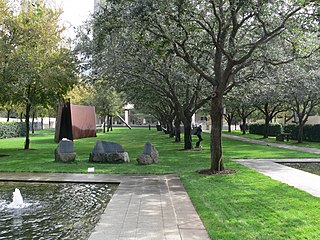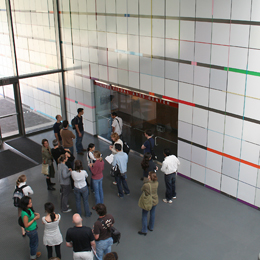
Alexander Calder was an American sculptor known both for his innovative mobiles that embrace chance in their aesthetic, his static "stabiles", and his monumental public sculptures. Calder preferred not to analyze his work, saying, "Theories may be all very well for the artist himself, but they shouldn't be broadcast to other people."

Leonard Charles Huia Lye was a New Zealand artist known primarily for his experimental films and kinetic sculpture. His films are held in archives including the New Zealand Film Archive, British Film Institute, Museum of Modern Art in New York City, and the Pacific Film Archive at University of California, Berkeley. Lye's sculptures are found in the collections of the Whitney Museum of American Art, the Art Institute of Chicago, the Albright-Knox Art Gallery and the Berkeley Art Museum. Although he became a naturalized citizen of the United States in 1950, much of his work went to New Zealand after his death, where it is housed at the Govett-Brewster Art Gallery in New Plymouth. He is best remembered for his 1933 short film "experimental Animation 1933," better known as "The Peanut Vendor."

Robert Bacon was an American statesman and diplomat. He was also a leading banker and businessman who worked closely with Secretary of State Elihu Root, 1905-1909, and served as United States Secretary of State from January to March 1909. He served as ambassador to France 1909 to 1912. He was a leader in the Preparedness Movement setting up training programs for would-be Soldiers before the United States entered the First World War in April 1917. He was defeated narrowly as a candidate for the United States Senate in 1916. He was commissioned as a major in the United States Army in 1917, and played a major role as Chief of the American Military Mission at British General Headquarters.

The Seattle Art Museum is an art museum located in Seattle, Washington, United States. The museum operates three major facilities: its main museum in downtown Seattle; the Seattle Asian Art Museum in Volunteer Park, Capitol Hill; and Olympic Sculpture Park on the central Seattle waterfront, which opened in 2007.

The Louisiana Museum of Modern Art is an art museum located on the shore of the Øresund Sound in Humlebæk, 35 km (22 mi) north of Copenhagen, Denmark. It is the most visited art museum in Denmark, and has an extensive permanent collection of modern and contemporary art, dating from World War II to the present day; in addition, it has a comprehensive programme of special exhibitions. The museum is also acknowledged as a milestone in modern Danish architecture, and is noted for its synthesis of art, architecture, and landscape, such as was showcased in an installation entitled "Riverbed" shown in 2014–2015. The museum occasionally also stages exhibitions of work by the great impressionists and expressionists, such as Claude Monet, who was the focus of a major exhibition in 1994.

Alexander Stirling Calder was an American sculptor and teacher. He was the son of sculptor Alexander Milne Calder and the father of sculptor Alexander (Sandy) Calder. His best-known works are George Washington as President on the Washington Square Arch in New York City, the Swann Memorial Fountain in Philadelphia, and the Leif Eriksson Memorial in Reykjavík, Iceland.

Opened in 2003, the Nasher Sculpture Center is a museum in Dallas, Texas, that houses the Patsy and Raymond Nasher collection of modern and contemporary sculpture. It is located on a 2.4-acre (9,700 m2) site adjacent to the Dallas Museum of Art in the Dallas Arts District.

Mountains and Clouds is a sculpture by Alexander Calder located in the Hart Senate Office Building.
Wire sculpture is the creation of sculpture or jewelry out of wire. The use of metal wire in jewelry dates back to the 2nd Dynasty in Egypt and to the Bronze and Iron Ages in Europe. In the 20th century, the works of Alexander Calder, Ruth Asawa, and other modern practitioners developed the medium of wire sculpture as an art form.

Herbert Matter was a Swiss-born American photographer and graphic designer known for his pioneering use of photomontage in commercial art. Matter's innovative and experimental work helped shape the vocabulary of 20th-century graphic design.

Flamingo, created by noted American artist Alexander Calder, is a 53-foot-tall (16 m) stabile located in the Federal Plaza in front of the Kluczynski Federal Building in Chicago, Illinois, United States. It was commissioned by the United States General Services Administration and was unveiled in 1974, although Calder's signature on the sculpture indicates it was constructed in 1973.

Established in 1950, the List Visual Arts Center (LVAC) is the contemporary art museum of the Massachusetts Institute of Technology. It is known for temporary exhibitions in its galleries located in the MIT Media Lab building, as well as its administration of the permanent art collection distributed throughout the university campus, faculty offices, and student housing.

La Grande Vitesse, a public sculpture by American artist Alexander Calder, is located on the large concrete plaza surrounding City Hall and the Kent County Building in Grand Rapids, Michigan, United States. Popularly referred to as simply "the Calder", since its installation in 1969 it has come to be a symbol of Grand Rapids, and an abstraction of it is included in the city's official logo.

Gwenfritz is a painted steel abstract stabile, by Alexander Calder. It is located at the National Museum of American History, at 14th Street, and Constitution Avenue, in Washington, D.C.

The Four Elements is a monumental mobile sculpture created by the American sculptor Alexander Calder in 1961. The sculpture is a motorized moving group of four metal sheets. The artwork is about 30 feet high. The sheets are painted in plain colours. This sculpture is made after a Calder model from 1938.

The original Decor for Satie's "Socrate" was designed by mobile artist Alexander Calder for a touring performance of Erik Satie’s symphonic drama Socrate in 1936. It was a mobile set considered by Virgil Thomson as one of the masterpieces of twentieth-century theatre design. It consisted of three elements: a red disc, interlocking steel hoops, and a vertical rectangle, black on one side and white on the other, against a blue backdrop. Destroyed in a fire in 1936, the decor was recreated by Walter Hatke in 1976 for a performance in New York.

Bent Propeller was a red stainless steel sculpture by Alexander Calder.

Spinal Column is a 1968 sculpture by Alexander Calder. It was commissioned for the San Diego Museum of Art in 1968 and was displayed in the May S. Marcy Sculpture Garden before being installed outside the museum. The work measures 118 in. x 100 in. x 90 in.

The Snow Flurry design was used by American artist Alexander Calder for at least seven mobiles between 1948 and 1959. A monumental design composed of white disks of varying sizes are connected on different branches and levels to reflect a snow flurry in Calder's distinct Modernist style.


















